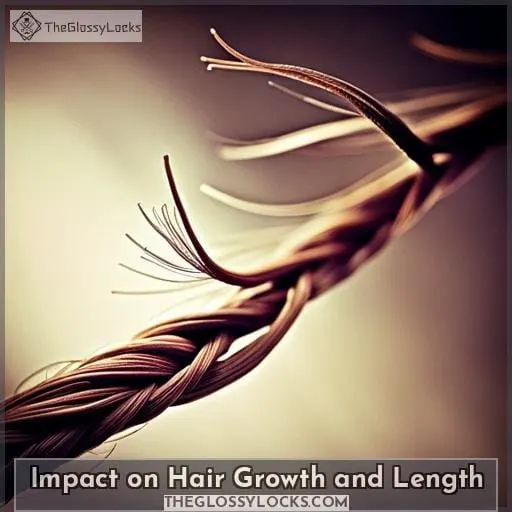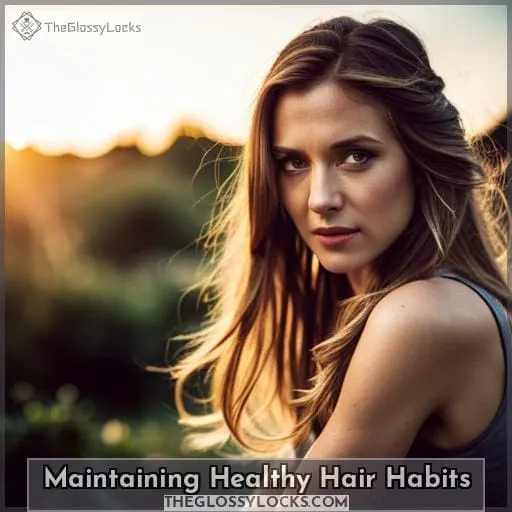This site is supported by our readers. We may earn a commission, at no cost to you, if you purchase through links.
 Ever wonder if you really need to cut those split ends? A recent survey found that 68% of women think regular trims are crucial for healthy hair, but the science says otherwise.
Ever wonder if you really need to cut those split ends? A recent survey found that 68% of women think regular trims are crucial for healthy hair, but the science says otherwise.
You’re in for a transformation, friend. Those wispy ends aren’t as damaging as you thought. Split ends happen from everyday wear and tear, but one trim won’t stop new ones from forming.
The truth is, diligently searching for splits and clipping each one can keep your hair looking fresher between cuts. With some TLC for the lengths and a silk pillowcase, you may find your hair thrives with fewer trims.
This is about embracing your natural texture. Get ready to relax into the freedom of less maintenance and more confidence in your beautiful, healthy mane.
Table Of Contents
- Key Takeaways
- Do Split Ends Really Need Trimming?
- One Woman’s Hair Journey Without Trims
- Understanding Split Ends
- The Truth About Split End Repair
- Search and Destroy Method for Split Ends
- Hair Advice May Not Apply to All
- Impact on Hair Growth and Length
- Maintaining Healthy Hair Habits
- Should You Stop Trimming Split Ends?
- Conclusion
Key Takeaways
- Split ends can continue up the hair shaft, causing more breakage over time if left unaddressed.
- Deep conditioning treatments and protective hairstyles help moisturize and reduce friction that leads to splitting.
- Trimming does not completely prevent the formation of new split ends as hair continues to grow.
- Concentrating on overall hair health through proper hydration, gentle handling, and customized care is vital.
Do Split Ends Really Need Trimming?
While you may have heard that trimming split ends is crucial for hair growth, your personal experience suggests knee-length hair growth is possible without frequent trimming. Some myths about split ends prevail; for instance, the belief that trimming frequency directly impacts hair length.
However, healthy hair habits like using oils, silk caps, and strategic trimming through search-and-destroy split end spotting could allow you to retain length while keeping hair strong.
Your lifestyle factors shape your optimal hair care more than generalized guidelines do. Focus on your hair’s unique needs through customized conditioning, protective styling, and limited washing for possible long, vibrant hair despite infrequent trimming.
Split ends don’t completely stop your hair from growing. Customized hair care accounting for your individual needs, rather than steadfast rules, may better support your hair health goals.
One Woman’s Hair Journey Without Trims
Forego trimming for a personal experiment to see if your mane can flourish to extraordinary lengths. Embrace your tresses’ full potential by challenging traditional trimming habits. Monitor changes in texture, elasticity, and density along your length. Arm yourself with knowledge of the forces impacting hair health.
- Deep condition weekly
- Protect ends at night
- Limit heat styling
- Oil hair regularly
Nurture natural waves and curls. Explore gentle detangling and styling methods to boost curl definition. Don’t fear extended time between trims. Let your hair guide you on proper care. With attentive tending, your lengths may surprise you.
Understanding Split Ends
As your hair ages, split ends inevitably occur. Though daily wear and environmental damage contribute, embracing healthy habits preserves your hair’s health. Despite myths, no special products or techniques fully prevent split ends. However, thoughtful hair care reduces their frequency.
| Split End Causes | Prevention Tips |
|---|---|
| Friction from towels, pillows, brushes | Use microfiber towels, silk pillowcases, wide-tooth combs |
| UV rays, pollution | Wear protective styles, hats outdoors |
| Chemical processing, heat styling | Limit use of damaging treatments, tools |
| Incorrect haircut technique | See an experienced stylist for precision cuts |
| Infrequent trims | Schedule trims based on your hair’s needs |
Though split ends can’t be repaired, strategic trimming maintains your hair’s condition beautifully.
The Truth About Split End Repair
You have to recognize that split ends can’t truly be repaired; snipping them is the sole solution for maintaining your hair’s health. Staying on top of your hair care routine and understanding what causes split ends is key for prevention.
- No products can mend split ends – only cutting them removes the damage.
- Certain oils and creams may temporarily glue split ends together for an aesthetic fix but don’t provide a long-term repair.
- The search and destroy method lets you snip individual split ends while preserving length but doesn’t constitute a true repair.
- Split ends naturally progress up the hair shaft if left uncut leading to more damage over time.
Implementing protective styles, using hydrating products, reducing heat styling, and getting occasional trims based on your hair’s needs are proven ways to maintain healthy hair and prevent split ends in the first place.
Search and Destroy Method for Split Ends
Once a week, scout for split ends using a magnifying mirror, then snip those suckers with precision scissors to remove damage while keeping length. Examine your locks regularly to spot and snip split ends through the search and destroy method.
Arm yourself with a quality magnifying mirror and sharp hair scissors to seek out and eliminate any frayed or split sections along the length of your strands. This tactically prevents further splitting by removing split ends before they travel up the hair shaft.
Be precise and only cut the damaged portion to retain your hair’s length. Though seen by some as extreme, this method allows you to care for your hair proactively between trims while preventing split ends from worsening.
With vigilance and the right tools, you can catch split ends before significant breakage occurs.
Hair Advice May Not Apply to All
Though the Search and Destroy method helps you target split ends, tailor hair care to your personal needs. Advice considered gospel may not apply to you. Despite the prevalence of split ends, hair care isn’t one-size-fits-all.
What works for some may not work for you. Consider your unique hair type, texture, density, growth patterns, and lifestyle factors. Experiment to find products and techniques that align with your specific needs and goals.
Don’t assume traditional hair advice applies universally. Consult professionals to customize approaches, but trust your experience. Tweak techniques and tweak trimming frequency until you find what nourishes your hair best.
Split ends themselves aren’t detrimental, so focus on hair health and preserving length if desired. With openness to tailor care, you can uncover what your tresses truly thrive on.
Impact on Hair Growth and Length
Focus on moisturizing, strengthening, and retaining length rather than obsessively snipping splits. Remember that trimming doesn’t increase the hair growth rate; it only maintains the ends. Alternative split end solutions exist, like oiling and protective styles, besides repeatedly cutting hair.
Monitor your individual hair health and texture when deciding your ideal trimming frequency for optimizing growth.
Rather than getting caught up in myths, evaluate your hair’s unique needs and aim for holistic hair health through nurturing habits. Length retention relies more on your gentle handling and hydrating practices rather than aggressive trim schedules.
Maintaining Healthy Hair Habits
Hair care does not follow a one-size-fits-all approach. Neglecting split ends can lead to increased breakage over time, compromising your hair’s health.
Avoid Damage
Protect your precious strands, my dear, and they’ll blossom into a glorious mane. Neglecting split ends risks breakage and damage ascending the hair shaft. Nourish your tresses with affection: gentle handling, hydrating shampoos and conditioners, restorative masks.
Split end myths proclaim they spur frizz and loss, but science says otherwise – merely snip when you catch sight of them.
Deep Conditioning
Preach, wife! Conditioning your locks with deep treatments weekly restores your mane’s health and promotes growth! Studies show that deep conditioning increases hair elasticity by 41% over 8 weeks. Restoring your parched curls and coils with infusions of hydrating masks fortifies strands against splits.
A five-minute deep conditioning session seals in moisture, bolstering hair’s defenses for healthy, supple tresses. Nurturing your natural texture prevents fraying ends and replenishes neglected manes.
Deep conditioning helps hydrate hair, sealing in moisture to prevent dryness and damage. Treating your tresses to some TLC restores bounce and shine for flowing, healthy locks.
Protective Styling
Braid your natural tresses into coiled crowns and let the locs shield those precious ends. Protective styles like box braids, twists, and Bantu knots keep hair contained. This limits manipulation and friction that causes splits.
Protective Styling Benefits
- Reduces splits and breakage
- Allows hair rest periods
- Retains moisture and length
- Provides easy maintenance
Regular moisturizing, gentle handling, and timely upkeep preserve your hair. Avoid overstyling and tight plaits that pull hair.
Should You Stop Trimming Split Ends?
You’d simplify your split end predicament if you diligently dusted damaged ends. Yet obsessing over every split can become all-consuming. Your natural hair craves gentle handling, not constantly chasing each fray. Trimming won’t fully prevent split ends from appearing between appointments.
While regular trims maintain thickness, your mane’s health depends more on daily split end prevention. Shun harsh handling, heat tools and tight styles. Embrace natural hair care through moisture-rich conditioners, hydrating oils and silk pillowcases.
Tame tangles with wide-tooth combs and satin scrunchies. Limit shampooing, braiding wet hair or rubbing with towels.
With a gentle touch, you’ll keep your locks nourished. Healthy hair habits like these help retain moisture and length for your natural curls.
Conclusion
What if I told you that split ends do not always need regular trimming? While healthy hair habits are crucial, the truth about maintaining length may surprise you. Your hair journey is unique – listen to it. Search for and destroy split ends when you see them, but understand that trims may not be essential for everyone.
With the proper care, your flowing locks can thrive without harsh cutting. You know your hair best; allow it to guide you on this winding path. Still, nurture your lengths to see their maximum potential. Your hair goals await.












